Michigan in the Olympics

1908 - London
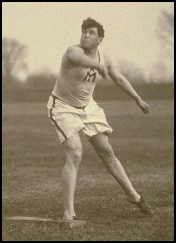
Ralph Rose won a second gold medal in the shot-put in London as Michigan men took three of the top four places in the event. The 6 ft. 7 in., 250 lbs. Californian attended U of M from 1903 to 1905. He won six medals in four events over three Olympics: 2 golds and a silver in the shot put, a gold in the combined left and right handed shot put in 1912, the only time it was an Olympic event, a silver in the discus, and a bronze in the hammer throw. He also finished 6th in the 56 pound weight throw in 1904.
Rose's only year of competition for Michigan was 1904 when he won both the shot put and discus at the Big Ten Championships. In the Fall of 1904 Rose was coaxed into trying out for the football team but apparently was not quick enough to play the line on coach "Hurry Up" Yost's point-a-minute team.
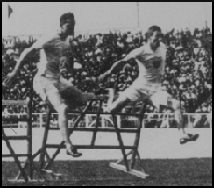
John Garrels was a double medalist, winning a silver in the 110 meter hurdles and a bronze in the shot put. Garrels was a star halfback on the 1905-1906 football team and lettered in track 1904-1907. He won the conference title in the 120 yard hurdles in 1906 and the discus in 1905 and 1906. William Coe, who earned his track "M" in 1906, finished fourth in the shot put in London after taking a silver in 1904.
John Garrrels, on the right, winning silver in the hurdles.
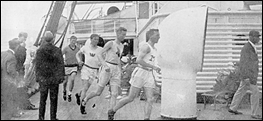
Gayle Dull leads practice en route to London.
Gayle Dull took part in the three mile team race which was scored like a cross country race; the times of the top three finishers for each country were combined to determine the final standings. The U.S. took the silver medal, but Dull was not among the top three finishers. Dull finished 2nd in his qualifying heat of the 3200-meter steeplechase and did not advance to the finals. He was also entered in the 1500-meter and 5-mile races but did not compete.
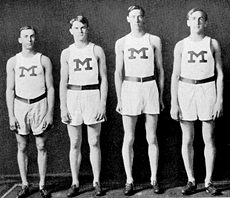

left: 1906 Four Mile Relay Team - J. W. Maloney,
Horace Ramey, Harry Coe, Floyd Rowe
right: Gayle Dull
Harry "Spider" Coe competed in the 800 and 1500 meter races and the 400 meter hurdles but did not place. Horace Ramey ran in the 400 and 800 meter races but was eliminated in the preliminary heats in both events.
Floyd Rowe was named to the US team and was entered in the 3200 m. steeplechase, 1500 m. run, and the 5-mile race but did not compete.
Ramey (1905-1907), Coe (1905-1908), Rowe (1905-1908), and Dull (1908) were the heart of Michigan four mile relay teams that captured six consecutive titles at the Pennsylvania Relays, which was then considered the national championship.
The 1906 team featuring Ramey, Coe, J. W. Maloney and Floyd Rowe set and broke the world record several times. The sixth title in 1908 came by default when the eastern teams agreed to concede to the heavily favored Wolverines on condition that Michigan enter a team in the two mile relay. The eastern strategy failed as the Michigan team of Donald May, Dull, Coe and Rowe set an intercollegiate record of 8:04.2, finishing 60 yards ahead of second place Pennsylvania.

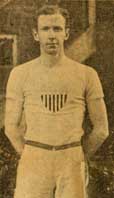
John Neil Patterson, who was enrolled at U of M in 1906/07-1907/08, competed in the London games representing the
Chicago Athletic Club. He placed 7th in the running high jump with a leap of 1.83 meters. Patterson graduated
from Detroit University School in 1906. He won the Penn Relays in 1905 with a National Scholastic record of 6'1 1/4".
In June of 1906 he set the World Scholastic mark at 6'2". Patterson was a member of the U of M track team his freshman year and though he could not compete in varsity meets, he did win the high jump in several intra-squad competitions.
right: John Neil Patterson as U-M Freshman and U.S. Olympian.

Rose competing in London
Rose starts a tradition
In addition to his medals, Rose is usually credited with beginning an American Olympic tradition in London. Even before the games began there had been disputes between the British and the U.S. over rules and scheduling. Matters became worse when it became apparent there were no American flags among the hundreds that decorated the stadium for the opening ceremony. Team captain Martin Sheridan, Rose's rival in the discus, had been selected to carry the U.S. flag in the opening parade but was replaced by Rose at the last moment. (Possibly because team trainer Mike Murphy ordered athletes competing the next day not to march in the parade, or perhaps because Sheridan, representing the Irish-American Athletic Club, could not be counted to show proper respect towards King Edward VI.)
In any event, as Rose passed the royal reviewing stand he did not dip the flag as protocol required. In some accounts of the event Rose and in others Sheridan is quoted as saying, "This flag dips for no earthly king." For years the U.S. flag bearer followed the precedent set by Rose.
The U-M Results-1908
| Ralph Rose | ||
| shot put | 1st, 46 ft. 7.5 in | |
| discus | did not place | |
| tug-of-war | ||
| John Garrels | ||
| shot put | 3rd, 43 ft. 3 in. | |
| 110 hurdles | 2nd, 15.7 sec. | |
| discus | did not place | |
| William Coe | ||
| shot put | 4th, 42 ft. 10.5 in. | |
| tug of war | ||
| Harry L. Coe | ||
| 800 meters | did not place | |
| 100 meters | did not place | |
| 400 meters | advanced to semi-finals | |
| Horace Ramey | ||
| 400 meters | did not place | |
| 800 meters | did not place | |
| Gayle Dull | ||
| 3-mile team race | 2nd (US won silver medal, but Dull was 4th US finisher and did not count in team scoring) | |
| 3,2000 m. steeplechase | did not place (2nd in qualifying heat #4 | |
| 1500 m. run | did not compete | |
| 5 mile run | did not compete | |
| Floyd Rowe | ||
| 3,2000 m. steeplechase | did not compete | |
| 1500 m. run | did not compete | |
| 5 mile run | did not compete | |
| John Neil Patterson | ||
| running high jump | 7th | |
| 110 m. hurdles | ||
Table of Contents | 1906-Athens | 1912-Stockholm | Name Index

